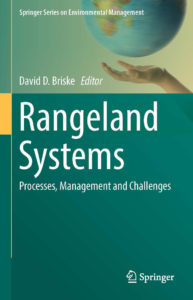Farm & Ranch
[AgriLife Today] New rangeland book addresses recent developments, future needs

By: Kay Ledbetter
Texas A&M author: ‘Unprecedented compilation’ of knowledge
Writer: Kay Ledbetter, 806-677-5608, [email protected]
Contact: Dr. David Briske, 979-845-5581, [email protected]
COLLEGE STATION – “Rangeland Systems – Processes, Management and Challenges,” an unprecedented compilation of ecological and management knowledge regarding global rangelands has been released, according to the Texas A&M professor and the book’s editor.

New compilation of ecological and management knowledge regarding global rangelands has been released in a book edited by Dr. David Briske. (Courtesy photo)
Dr. David Briske, T.M. O’Connor Professor in the Texas A&M University department of ecosystem science and management in College Station, said the book represents a major work involving the collective experience, knowledge and commitment of 80 authors in 15 countries who work in rangelands throughout the world.
The book has been published in the Environmental Management series by Springer Publishing Company. The electronic version can be found or a hardcover purchased at http://bit.ly/2mcHYhA.
Briske earned a bachelor’s in botany from North Dakota State University and a doctorate from Colorado State University. His scholarship and pedagogy emphasize the ecological function and management strategies of global rangelands.
He has served as editor of the book “Conservation Benefits of Rangeland Practices” and the journal “Rangeland Ecology and Management.”
“Originally, we had discussed updating ‘Grazing Management: An Ecological Perspective,’ a book first published in 1991,” he said. “However, it became apparent that rangeland science had advanced so rapidly in the 25 years since that book had been published, its scope was no longer sufficient to accommodate the newly created knowledge.”
Consequently, he said, the authors decided a new book with an expanded scope and greater relevance to contemporary rangeland challenges was required.
Briske said the new book also assesses why these major advances occurred so rapidly following a half century of limited conceptual change.
“Major advances have primarily been represented by scientific contributions such as non-equilibrium ecology and resilience theory, but sociopolitical events, including new policy and increasing societal demand for rangeland services, have also been important,” he said.
The book emphasizes three major themes, Briske said. The first summarizes recent conceptual advances for rangeland science and management. The second addresses the implications of these conceptual advances with respect to management recommendations and policy decisions. The third evaluates some of the major challenges confronting global rangelands in the 21st century.
“This book is intended to compliment applied range management textbooks by evaluating the conceptual foundation of the profession and recommending changes to promote future development and greater effectiveness,” Briske said. “It is written in a style intended for a broad audience, including ecosystem managers, educators, scientists and policy makers.”
Collectively, the authors indicate a more comprehensive framework is necessary to address the complex challenges confronting global rangelands in the 21st century. Rangelands represent integrated social-ecological systems, in which societal values, organizations and capacities are of equal importance to those of ecological processes.
“It is our assessment that a more comprehensive framework of rangeland systems may enable management agencies, and educational, research and policy-making organizations to more effectively assess complex problems and develop appropriate solutions,” Briske said.
-30-
Find more stories, photos, videos and audio at http://today.agrilife.or
Farm & Ranch
Hazards of Backyard Poultry

By Barry Whitworth, DVM
Having backyard poultry is a popular agriculture enterprise. According to the United States Department of Agriculture, 0.8 percent of all households in the United States have chickens. People keep chickens for a variety of reasons with table eggs being one of the more common reasons.
Unfortunately, some of these poultry producers are not aware of the hazards that come with keeping poultry because many times they carry pathogens but appear healthy.
Chickens are carriers of several zoonotic diseases. These are diseases that can be passed from animals to humans. According to a recent survey in Pennsylvania, a majority of backyard poultry producers were aware of the dangers of avian influenza. However, this study also revealed that far fewer producers were aware of the risk of possible exposure to Salmonella and Campylobacter.
The lack of knowledge about the hazards of raising poultry likely contributes to the continued issues of Salmonella outbreaks associated with backyard poultry. In 2023, the Centers for Disease Control and Prevention reported 1,072 illnesses of Salmonella linked to backyard poultry, and 272 of those patients required hospitalization. Oklahoma reported 43 individuals with the disease.
To read more, pick up a copy of the April issue of NTFR magazine. To subscribe by mail, call 940-872-5922.
Farm & Ranch
Ag Elsewhere: Wyoming

By Tressa Lawrence
Babies are tucked away in every nook and cranny. Many ranchers across Wyoming have baby animals popping up all over this time of year.
Farm & Ranch
Ag Elsewhere: Montana

By Lindsey Monk
Another load of grain in to keep feeding the calves until the green grass can really start popping.
-

 Country Lifestyles1 year ago
Country Lifestyles1 year agoScott & Stacey Schumacher: A Growth Mindset
-

 Equine7 months ago
Equine7 months agoThe Will to Win
-

 Country Lifestyles7 years ago
Country Lifestyles7 years agoStyle Your Profile – What your style cowboy hat says about you and new trends in 2017
-

 Country Lifestyles4 years ago
Country Lifestyles4 years agoAmber Crawford, Breakaway Roper
-

 HOME7 years ago
HOME7 years agoGrazing North Texas – Wilman Lovegrass
-

 Country Lifestyles7 years ago
Country Lifestyles7 years agoDecember 2016 Profile, Rusty Riddle – The Riddle Way
-

 Country Lifestyles8 years ago
Country Lifestyles8 years agoJune 2016 Profile – The man behind the mic: Bob Tallman
-

 Outdoor9 years ago
Outdoor9 years agoButtercup or Primrose?






